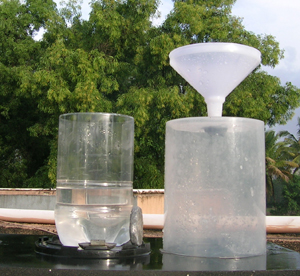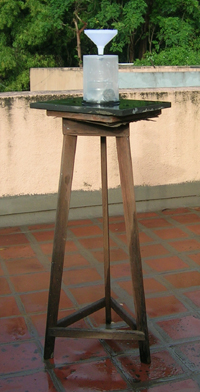Rain Gauge
DIY - Model 1
Measuring rain water volume
Material needed:
The basic material need is a funnel and a measuring cylinder. A good
quality plastic funnel can be purchased from a grocery shop. We would
require a measuring cylinder that can read at least 1 milliliter of volume.
This can be purchased from a laboratory suppliers or science teacher of a
near by school should be able to tell you where to buy one. For rest of the
material you may follow the instructions below and/or improvise on it.
Rain Gauge DIY model 1
For our rain gauge we used 100 CD/DVD cake box with its spindle removed. On the top the cake box cover we cut a hole and inserted neck of funnel through it and glued it water resistant glue such as M-seal. A vessel to collect the rain water is placed on the base of the cake box. The cover can be locked to its black base.
This unit turned out to be quite light and could easily fly away with moderately strong wind. We found a 40 x 40 cm and 18 mm thick water proof wooden board in our carpentry workshop. So we screwed the base of the CD cake box to the board. Underneath this board we also fixed four caps of mineral or soft drink water bottles. One of the bottle could be cut to fit inside the cake box to serve as vessel for collecting rain water.
Rain gauges, like most meteorological instruments, should be placed far enough away from structures and trees to ensure that any effects caused are minimized.
We simplified the above design by removing the wooden board and putting lead
weights and used a pet bottle as a vessel for collecting the rain water. We
also found a tall stool to place this rain gauge.
Download Microsoft Exel file for recording your rain fall measurement. Right click on download and Save target as .. in appropriate directory. You will have to replace the value of 'dc' as per the diameter of the funnel used by you.
Please note:
Some of the observations taken may not be as good as those taken by professional observatories but the aim here is to learn to do scientific experiments and take observations, as accurately as possible.
Send us your design (s) - we would be happy to share it with others


 The material here can be used freely. It is however expected that the source will be acknowledged.
The material here can be used freely. It is however expected that the source will be acknowledged.